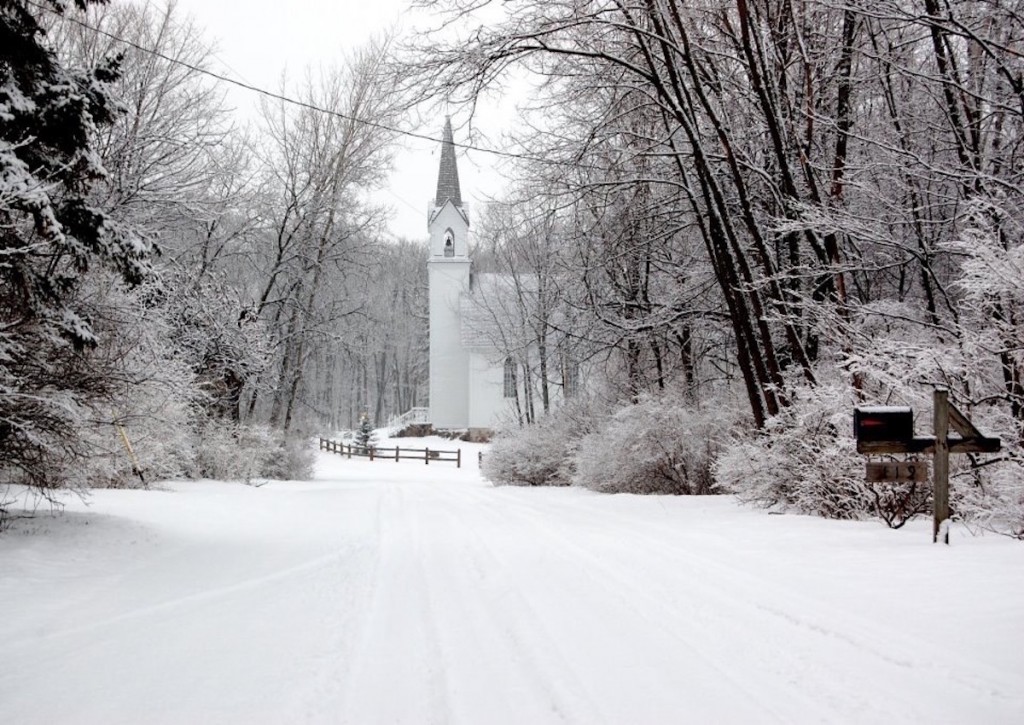Nestled along a portion of scenic highway snaking its way around the curves and turns of the Lake Michigan shoreline is Good Hart. In addition to its’ status as a thriving resort area, Good Hart also has the privilege of a history rich in Native American lore and local legend.
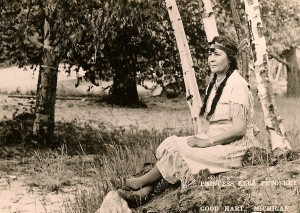 Native American History
Native American History
The area of land following the winding bluffs overlooking Lake Michigan between Harbor Springs and Cross Village has been called by many names throughout the years.
Originally Native Americans knew it as L’Arbor Croche, meaning “crooked tree”. The name derived from an enormous tree with a crooked top reported to be just west of the foot of the hill on Lamkin Drive in Good Hart. The tree was used as a landmark to those traveling by canoe in the area.
Indian camps were first established all along the Lake Michigan shoreline at various points including Cross Village, Middle Village (Good Hart), Seven Mile Point (seven miles north of Harbor Springs), and Harbor Springs.
When the area now known as Good Hart was singled out, it was called Waw-gaw-naw-Ka-see, meaning “crooked tree” in Ottawa. It was also referred to as Opit-awe-ing, meaning halfway for halfway between Harbor Springs and Cross Village. White settlers would call it “Middle Village” and then “Good Hart”.
In 1827 the subjects at Middle Village were left to their chief’s brother, Kaw-me-no-te-a, which means “good heart” in Ottawa. The word was somehow misspelled along the way, and the error remains today.
Descendants of original settlers still remain in the area.

St. Ignatius Church
Just south of Good Hart, travelers will see the very tip of a tall, white, clapboard church peeking through the thick trees on the shoreline below Lake Shore Drive (M-119). The steeple is that of St. Ignatius Church, the third structure to reside on the land.
The first Jesuit Mission was established at Middle Village in 1741 and was rebuilt by Native Americans in 1823. The current structure was built in 1889 after fire destroyed its predecessor. Originally known as the St. Ignatius of Loyola complex, the structure is now simply St. Ignatius Church, and can be seen from Lake Shore Drive just south of Good Hart. The church was established on the State of Michigan’s Register of Historic Sites in 1977. Also present is a Native American burial ground marked by small white crosses, which began in the 1700’s when Middle Village was an established Indian village.
Trades and Talents
Some of the most beautiful decorative pieces and artwork came from the area’s first residents.
Straw and sweet grass baskets, beaded medallions, quill boxes, and birch bark baskets remain treasured items that are no longer as easy to come by. Agnes Shenanaquet, an Ottawa resident of Good Hart was known nationally for her spectacular pine quill boxes.
In 1981 Mrs. Shenanaquet received the Triple A rating from the Smithsonian Institution for her quill basket work at the 15th Annual Festival of American Folklore in Washington, D.C.
Living without electricity well into her late 60’s, she would make two each week and sell them for $40 to local traders. Quill boxes today can cost as much as $600 for the intricate work done commonly in days gone by. Mrs. Shenanaquet died the year after her visit to Washington; her boxes and baskets and similar pieces remain treasured pieces of art throughout the world.
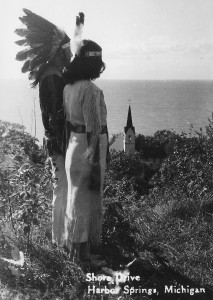 Fabled “Indian Drum”
Fabled “Indian Drum”
According to Indian legend, an ominous drum is said to be heard in the air each time a life is lost in the treacherous waters of Northern Lake Michigan. Although only legend, it is up to the visitors to decide whether or not the fable is true.
Original Industry
Original industry in the area included fur trading, fishing, farming, and logging.
A Resort Destination
Through additional means of transportation, the early 1900’s allowed Good Hart to become a prominent resort area. Nearby Harbor Springs became a summer playground for the rich, drawing summer residents from Detroit, Chicago, and St. Louis. In Good Hart, lakefront and bluffside resorts began to emerge as a stable means of income for their proprietors.
One notable resort was the Lamkin Lodge located at the base of Lamkin Road in Good Hart. The original resort was built in 1912 by Mr. And Mrs. Lowell Lamkin and housed a summer hotel, rental cottages, general store, and post office where both husband and wife served at postmaster. The store was also home to the first school for Native Americans located in Good Hart. A post-WWII gas explosion destroyed the entire original structure, but left the resort cottages and dining house in tact.
Another successful resort offering visitors the peace and tranquility of Northern Michigan was the Krude Kraft Lodge, which is still in existence as a private home just 2 miles north of Good Hart along Lake Shore Drive. The property was originally developed by the Bliss family, and was operated by Chauncey P. Bliss and his wife, Mrs. May C. Bliss. Mr. Bliss was a local legend in development and was responsible for creating the famed Bliss Log Home style of cottage construction.
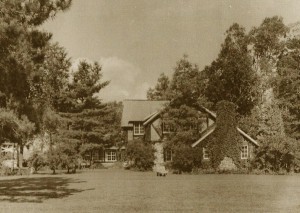 The Bliss Log Home
The Bliss Log Home
Chauncey P. Bliss and his son, Chauncey A. Bliss are responsible for some of the areas most unique and attractive homes. Constructed solely of solid log with field stone foundations and hand-hewn beams, the properties are spread throughout the area and are easy to recognize by their individuality. Many properties from the 30’s, 40’s, and 50’s are still occupied today by the original families.
Creation of the First Township Park
The Readmond Township Park, located on the north end of Lamkin Drive was established as the county’s first park in the early 1950’s. Tony Kushak, then supervisor of Readmond Township found that a strip of land along Lake Michigan in Good Hart was for sale. With the support and assistance of many neighbors, the land was acquired for use of a public park. Although heavily wooded, the property was cleared through the hard work of many volunteers including Earl and Elmer Johnston, who spearheaded the operation. The park remains today a favorite spot for residents and visitors alike.
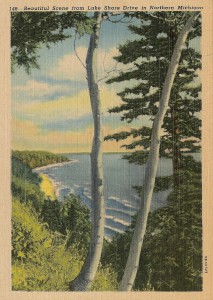 The Tunnel of Trees
The Tunnel of Trees
The area of Lake Shore Drive (M-119) between Harbor Springs and Cross Village is appropriately deemed, the “tunnel of trees” due to the dense shadowy woods tipping the high bluffs along the shores of Lake Michigan. No matter what season, the tunnel of trees offers visitors an unparalleled view of Lake Michigan and occasionally Beaver Island, Isle Aux Galets, and Waugoshance Point.
Historical Highway Markers
Traveling along Lake Shore Drive (M-119) through the “tunnel of trees” from Harbor Springs north to Cross Village, visitors will enjoy historical signs marking points of interest such as Devil’s Elbow and The Old Council Tree. The signs were originally erected in 1955 through the efforts of resident Chauncey Bliss of Good Hart and the Harbor Springs Chamber of Commerce. Through community efforts after the Millennium, the signs were restored and now offer brief history lessons to visitors in traveling the roads of the area once called L’Arbor Croche.
One of the most infamous markers explains the hairpin turn on Lake Shore Drive just south of Good Hart known to most as “Devil’s Elbow”. Indian legend states that Devil’s Elbow marks the location where the devil scooped out a giant hollow after Native Americans suffered a rampant plague. The original sign explained the eerie history:
Devil’s Elbow
A Flowing Spring In This Ravine Was Believed By Indian Tribes To Be The Home Of An Evil Spirit Who Haunted The Locality During The Hours of Darkness
It has been said that former residents could hear “voices and sounds” coming from the ravine after dark.
Approximately 4 miles north of Good Hart, travelers will see the location of The Old Council Tree, where famous tribal councils were held. One of the most legendary involved a meeting between Menominee, Chippewa, and Ottawa tribes after the massacre at near-by Fort Michilimackinac in July of 1763. The purpose of that gathering was to discuss further moves against the British.
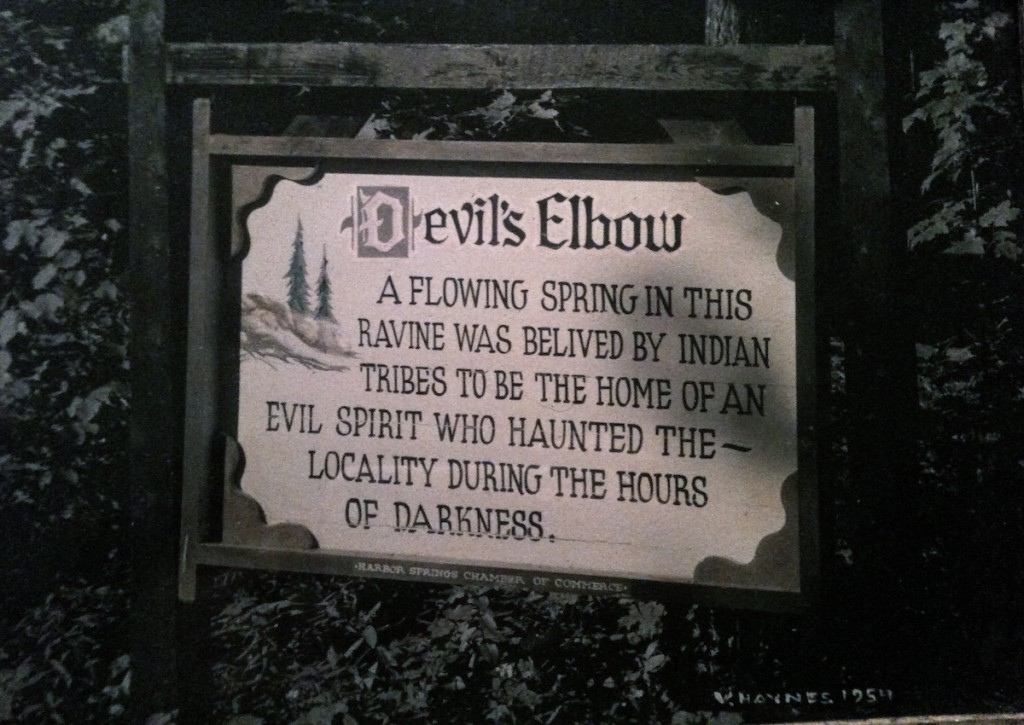
Michigan Outdoors
From raccoons crossing your deck at night, deer wallowing in the woods along the roads, and the spread of Trilliums each spring, northern Michigan provides a great backdrop by which one can fully appreciate all the natural beauty life has to offer. Many nature enthusiasts will remember the popular weekly Detroit television show, Michigan Outdoors, produced and hosted by former Good Hart resident, Mort Neff. Taking his love of northern Michigan’s natural beauty, Mr. Neff was able to bring a passionate understanding of the outdoors and conservation into the homes of thousands of people. Mr. Neff’s children and grandchildren remain in the area and are also involved in local conservation and nature preservation.
Community Development
One of the most heroic and substantial acts of community development involved the establishment of the Readmond-Friendship Volunteer Fire Department. A committee of residents in 1979 banned together to begin a mission offering emergency fire and medical service to the residents of Good Hart and Cross Village. Through much volunteer work and hours of individual service, a team of seven fire fighters was assembled in March of 1980 with the assistance of fund-raisers, individual donations, and corporate donations of equipment. Former resident Randel (Richner) Russell, a female fire fighter and registered nurse outfitted a donated 1974 SUV with necessary medical supplies and the area’s First Response Unit was born. The current operation includes thirty volunteer firefighters and seven EMTs and provides a greatly appreciated service to the residents and visitors of the area.
 Good Hart General Store
Good Hart General Store
The tiny red store in “downtown” Good Hart has a history all its own. The current structure was built by resident Cliff Powers in 1934 and operated as a general grocery, butcher, and gas station until 1971 when the Powers sold the business to current owner Carolyn (Woods) Sutherland, who currently operates the grocery, bakery, deli, and post office with husband Jim Sutherland. Although a post office was established at Good Hart in 1874, the current location was not used by the postal service until 1945 when Mr. Powers became postmaster.
Many original features of the store remain intact such as the tinted front windows, the glass-front counter bins, the 1903 National Cash Register (with warranty, albeit expired), and the carved oak “cooling case” which visitors probably don’t realize was in fact just that, a cooling case, which was installed before electricity was available in the area.
Today travelers along Lake Shore Drive (M-119) can’t help but notice the quaint general store situated steps from the scenic roadway nestled between the signs marking the area of Good Hart. Visitors will enjoy homemade baked goods and preserves, a delicious selection of prepared foods, a dizzying assortment of the area’s finest tees and sweats, and of course the store’s world famous chicken and beef pot pies made fresh and shipped throughout the country.
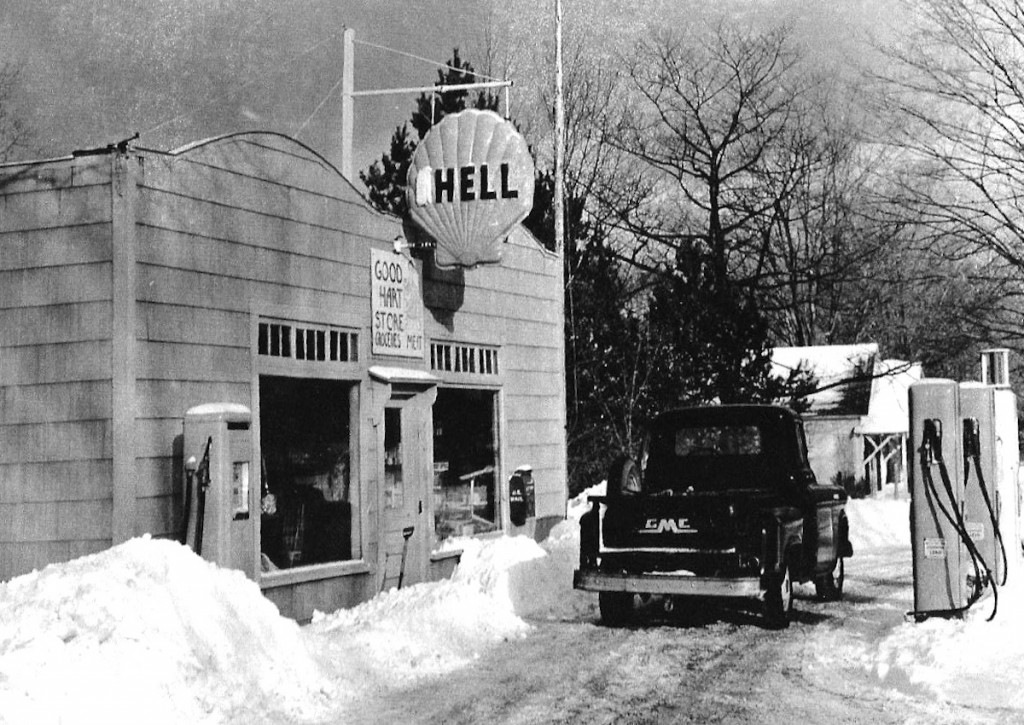
Graham Real Estate Good Hart
Carolyn Sutherland heads up the Graham Real Estate branch office housed in the Good Hart General Store. Her expertise has derived from over forty years’ experience in sales and rentals throughout Northern Michigan.
Downtown Good Hart
Visitors passing the green state highway signs, noting the beginning of this unincorporated, fairy-tale spot will now see the Good Hart of today. “Downtown” consists of the general store, A Studio (specialty gifts), and Primitive Images (rustic and local décor).
The only current industry in Good Hart is tourism and we hope you will soon experience it.
Sources: Harbor Light, Petoskey News-Review, National Archives, Detroit Free Press, Detroit News, & Michigan Fire Service News.
